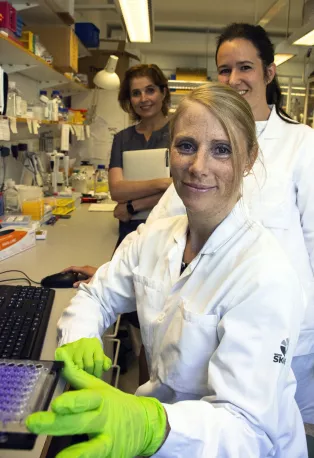Pathologic complement activation in diseases
Misguided or excessive complement activation is involved in many common diseases such as rheumatoid arthritis, systemic lupus erythematosus, vasculitis and age-related macula degeneration. In collaboration with clinicians we are studying molecular mechanisms of complement involvement in these diseases.
Joint inflammation in rheumatoid arthritis (RA), a common chronic inflammatory disease that causes long-term suffering and disability in 1% of our population, is a complex process also involving complement activation. Thus, complement is consumed and deposited in the joints during the active phase of RA. Mice lacking complement components do not develop RA and blocking of complement activation prevents arthritis. Traditionally, complement is considered to be a component of blood but in fact all its components are present in the synovial fluid of joints. During cartilage injury, large quantities of complement factors are exposed to components of extracellular matrix, which are liberated from cartilage by proteases. Therefore, we are investigating the possible modulatory effects that cartilage proteins may have on complement. We found already that fibromodulin and cartilage oligomeric matrix protein (COMP) are potent activators of complement. The clinical rationale for this project is based on the observation that cartilage contains molecules that initiate/enhance joint damage and inflammation in arthritis. Indeed, when the cartilage is removed surgically, a dramatic decrease in inflammation and disease symptoms is observed. We aim to identify further molecules involved in the activation of complement in joints in RA with the goal of developing diagnostic assays for diagnosis, prognosis and follow up of treatment.
Further we aim to study handling of apoptotic cells and DNA from various sources by complement, in relation to autoimmune diseases. Systemic lupus erythematosus (SLE) is a relatively common autoimmune disease involving skin, joints and kidneys and is characterized by autoantibodies against self-antigens including DNA and histones. Efficient uptake of dying cells and handling of their DNA is important for preventing intracellular autoantigens from coming into contact with the immune system. Impaired clearance of dying cells and their components is suggested to drive the autoimmune response in SLE. Many molecules including complement are involved in the recognition of dying cells as shown by phenotype displayed by patients lacking complement component, for example deficiency of C1q leads in 95% cases to SLE. A certain level of complement activation is a prerequisite for efficient and ‘silent’ disposal of dying cell debris, since complement proteins function as strong opsonins, but a tight balance must be maintained to prevent full-blown activation against self-antigens. Thus, in SLE complement acts as a double edge sword and while its genetic deficiency leads to SLE, complement also contributes to development of symptoms since there are immune complexes deposited in tissues and these activate complement. We are studying how apoptotic cells are recognized by C1q and complement inhibitors and what are functional consequences of these interactions.
One application of our research are improved diagnostic assays such as recently commercialized test measuring complement activations products C4d. This assay appears useful in following kindey disease in SLE.
Here is presentation of the commercial assay


